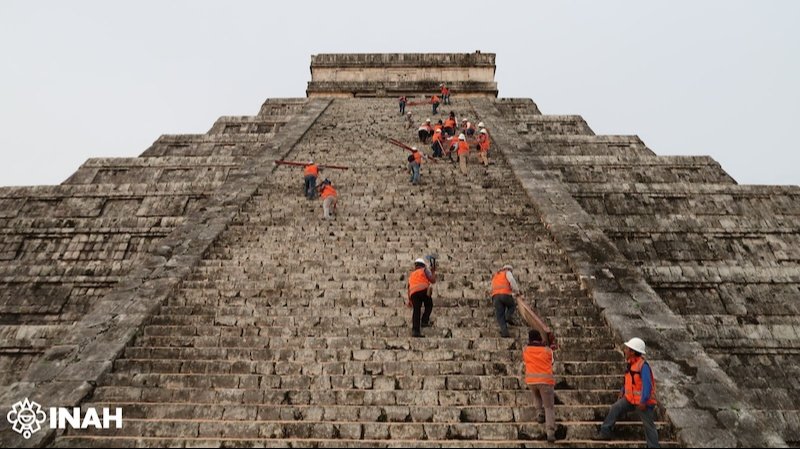Yucatán, Mexico — The Proyecto de Conservación Integral de Chichén Itzá (PCICI) has been awarded the INAH Paul Coremans/Laura Mora Prize in the Conservation of Movable Property category. The award distinguishes the work of a team that has maintained the vestiges of the ancient Maya civilization through a model combining science, community, and institutional commitment.
A Model of Integral Maintenance
The PCICI has become a national and international reference for its integral methodology. For over a decade, an interdisciplinary team has carried out systematic diagnostic, registration, and conservation actions on the main architectural complexes of Chichén Itzá.
Between 2022 and 2024, with support from the Programa de Mejoramiento de Zonas Arqueológicas (Promeza), the project underwent a qualitative leap. Twenty-two spaces within the visitor circuit were re-intervened with the purpose of preserving their physical integrity and iconographic readability. The public investment for this work was close to 24 million pesos.
More than 150 specialists, technicians, and members of nearby communities—including residents of San Felipe, X-Calakoop, and Pisté—participated in the tasks. This local integration not only strengthened the community fabric but also allowed for the transmission of knowledge about the care of the heritage that belongs to them.
Science in the Service of Stone
The INAH recognition underscores that the project was not limited to restoring visible structures. Cutting-edge scientific techniques were applied, including thermography, electrical resistivity, colorimetry, and measurements of material hardness, to precisely assess the conservation state of reliefs and walls.
In complex cases, nanomaterials were used to consolidate surfaces, an advancement that stabilizes the stone without altering its original color or texture. Specialists also conducted environmental monitoring of temperature and relative humidity to establish preventive conservation plans against the effects of climate and tourist traffic.
"Each wall and each relief were treated with the same sensitivity with which one would restore a work of art," stated the project coordinators, Claudia García Solís and Claudia Ocampo Flores of the Centro INAH Yucatán.
Emblematic Cases of Intervention
Among the most notable works are the restoration of the mural painting in the Upper Temple of the Jaguars, where pigments were cleaned, fixed, and protected with reversible materials; the attention given to the substructure of the Temple of the Warriors, where nanomaterials were applied for the first time at the site; and the conservation work in the Great Ball Court, whose relief sculptures were treated to recover the complete reading of their ritual scenes.
Actions were also carried out in the Nunnery Complex, the Platform of Venus, and other buildings that form part of the usual visitor route. Each intervention included photographic, topographic, and graphic recording of the processes, as well as the preparation of technical reports that will serve as a reference for future generations of conservators.
Documented Work
The PCICI does not only intervene in structures; it documents every finding and every decision. Its photographic and registry archive is a living database that allows for comparison, evaluation, and learning. Thanks to this, the INAH team can detect patterns of deterioration and propose long-term preventive conservation measures.
This scientific approach has been key to consolidating a "management of memory": conserving not only the walls but also the information they contain, the techniques with which they were worked, and the meanings they still communicate.
Promeza, A Commitment to Heritage
The impetus from the Programa de Mejoramiento de Zonas Arqueológicas (Promeza) was decisive for the project to achieve this scale. Public funds allowed for the hiring of specialized personnel, the acquisition of laboratory materials, and the maintenance of constant monitoring.
The program was not limited to Chichén Itzá; it also benefited other zones in the southeast linked to the development of the Tren Maya. However, in the case of the ancient Maya city, the results have been exemplary and recognized by the INAH as a model of integral intervention.
The work of the PCICI was also linked to the opening of the Gran Museo de Chichén Itzá, inaugurated in February 2024. The same conservation teams collaborated in diagnosing the pieces now displayed in that venue, in addition to supporting the development of the museographic script that contextualizes the objects in their original environment. In this way, the conservation of movable and immovable property connects with cultural dissemination, offering the visitor a complementary experience between the archaeological site and the museum.
Pressures and Challenges
Despite the advances, Chichén Itzá faces permanent challenges. With millions of visitors each year, the erosion caused by human traffic, heat, humidity, and rain represents a constant risk. INAH specialists have warned that the conservation of the zone requires sustained management plans and continuous resources, in addition to educational measures that promote respect among tourists.
Climate change and urban growth in the surrounding areas are other factors demanding attention. Hence the importance of the environmental monitoring and emergency protocols already designed within the project.
A Prize with Social Echo
The INAH Paul Coremans/Laura Mora Prize not only recognizes the technical excellence of the PCICI team but also validates a model that combines science, community participation, and institutional commitment. In the words of its coordinators, the award "represents the effort of many hands that, with patience and rigor, have returned stability and meaning to the structures that define the history of the Maya people."
Chichén Itzá remains, as it was over a millennium ago, a space where stone breathes, speaks, and teaches. Conserving it is not the task of a single moment, but a constant conversation between past and present, between matter and spirit. Today, that dialogue is awarded and reaffirmed as an example for all of Mexico.
Discover more from Riviera Maya News & Events
Subscribe to get the latest posts sent to your email.
